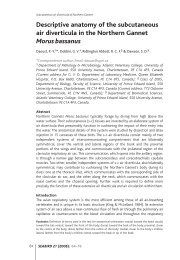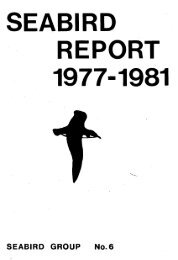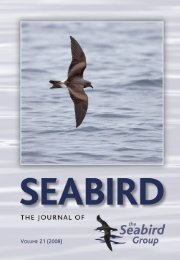Create successful ePaper yourself
Turn your PDF publications into a flip-book with our unique Google optimized e-Paper software.
198 W.R.P. BOURNE & K.E.L. SIMMONS Atlantic <strong>Seabird</strong>s 3(4)<br />
CONCLUSION<br />
It appears Ascension once formed the only breeding-station for a large, distinct<br />
community of seabirds, including the endemic Ascension Frigatebird and many<br />
more Red-footed Boobies than are found now, exploiting a biologicallyenriched<br />
area along the equatorial counter-current about 500 nautical miles to<br />
the north in the tropical Atlantic. Its numbers have been reduced over the last<br />
500 years as a result of human activity, especially the introduction of cats<br />
(Ashmole et al. 1994).<br />
It appears that while Ascension Sooty Terns breed very regularly every<br />
ten lunar months (Chapin 1954), there are also variations in the weather and<br />
seabird breeding success in this area comparable with those elsewhere. This<br />
may help explain the poor breeding success of some seabirds found by the BOU<br />
Expedition on Ascension in 1958-1959 (As mole et al. 1994). It is however<br />
notable that AOS censuses of Sooty Terns breeding on Ascension indicated a<br />
population of 176 000 in March 1990 before a breeding failure, 202,000 in<br />
<strong>No</strong>vember 1996, and 207 000 in June 1998 after a breeding failure the previous<br />
year (Hughes 1999). Thus these events do not appear to have affected the adult<br />
population of these and other seabirds, who can presumably if necessary<br />
disperse until conditions improve.<br />
Such events make it increasingly necessary to exercise care in<br />
interpreting such factors as breeding seasons, cycles and success and adult<br />
survival of seabird populations, since they may also have other more complex<br />
effects, including for example not only a change in the food supply, but in the<br />
weather, the vegetation, and the number of predators or competitors at the<br />
breeding places, cascading up and down the food-chain afterwards (Holmgren et<br />
al. 2001). <strong>The</strong>refore it seems desirable that attempts to rehabilitate the damaged<br />
ecology of oceanic islands should be accompanied by a long-term, but perhaps<br />
low intensity, international monitoring programme, as discussed in Symposium<br />
29 at the 19th International Ornithological Congress in 1986 (Schreiber & Duffy<br />
1988) and by Schreiber & Schreiber (1989).<br />
While there are records from western South America for a long period,<br />
and they are now made more widely in the eastern Pacific, there are still very<br />
few from elsewhere in the tropics. If possible in addition to Ascension they<br />
should be obtained from at least the islands in the Gulf of Guinea to the east and<br />
Fernando de <strong>No</strong>ronha and Rocas Reef to the west in the Atlantic, on Christmas<br />
Island (Schreiber & Schreiber 1984) and Henderson Island (Brooke 1995)<br />
where reduced seabird breeding success has occurred during ENSOs, but in the<br />
latter case was attributed to rats, among many other places in the Pacific, and on<br />
Christmas Island with another endemic frigatebird, Fregata andrewsi, and








